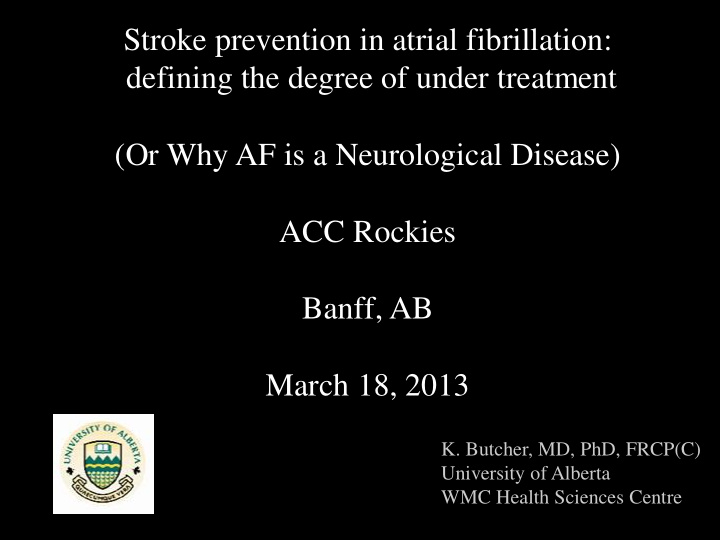



Stroke prevention in atrial fibrillation: defining the degree of under treatment (Or Why AF is a Neurological Disease) ACC Rockies Banff, AB March 18, 2013 K. Butcher, MD, PhD, FRCP(C) University of Alberta WMC Health Sciences Centre
Disclosures and Acknowledgements Grant-in-Aid Grant-in-Aid Salary Award Salary Award Salary Award Speaker’s / Adivosry Board Honoraria Boeringher Ingelheim Grant-in-Aid Bayer Salary Award BMS/Pfizer Octapharma Grant-in-Aid
Outline • AF is under-diagnosed • Anticoagulation is under-utilized • NOACs are under-utilized
Acute Stroke Diagnosis ICH (15%) Ischemic Infarct (85%)
Investigating Stroke/TIA Mechanism Lacunar Cortical Infarcts Infarcts (LACI) (PACI) Lipohyalinosis Artery-artery Embolism Cardioembolism
Stroke Mechanism Frequency Hemorrhagic stroke 12- 15% Other 5% Cryptogenic Atherosclerotic 30% cerebrovascular disease 20% Small vessel Cardiogenic disease embolism “ lacunes ” 20% 25% Ischemic stroke 85- 88% Albers GW, et al. Chest 2004; 126 (3 Suppl): 438S – 512S McGrath et al. Stroke 2012; 43: 2048-2054. .
49 year old Male: Cryptogenic Stroke DWI CTA • Normal TEE (no LA enlargement) • Normal 24 H Holter x 2 (no atrial ectopy) • Normal Hypercoagulable Screen
82 year old Female: Cryptogenic Stroke?? DWI • Carotid Doppler: No atherosclerotic plaque • TTE: LAA Enlargement • Holter: Frequent PACs/atrial ectopy
Cardioembolic Stroke: A Growth Industry Projected Number of Persons With AF Age- and Sex-Adjusted in the United States Between 2000 and Incidence of AF in 1995-2000 2050 Millions Year Miyasaka Circulation 2006;114:119
Cardioembolic Stroke
Typical Cardio-embolic Infarcts
Worse Prognosis Following Cardioembolic Stroke 35% One Year Risk of Death 30% 30% 25% 20% 15% 8% 10% 5% 1.4% 0% Small Vessel Large Vessel Cardioembolic Gladstone DJ et al. Stroke 2009; 40:235-240
Transient Left Hemiparesis ICA Plaque
Transient Left Hemiparesis Cardioembolic Pattern of Infarction (Paroxysmal AF later confirmed)
Cortical Ischemic Stroke (Embolic Pattern) Next Investigation?
Echocardiography Options Transthoracic Echocardiogram Transesophageal Echocardiogram
Higher Yield Cardiac Investigations Holter Monitor Implantable Event Recorders External Event Recorder (SpiderFlash)
Infarct Load Predicts Holter Yield Silent Infarct Number of Imaging 7 Identified Infarcts 6 Holter Yield Increases 5 % of Patients with with Ischemic Lesion 4 Paroxysmal Atrial 3 Load: 2 Fibrillation on Holter 1 1 2 3 4
EMBRACE Study Stroke/TIA and 1 negative Holter n=572 Accuheart Electrode Belt Repeat Holter Monior (30 days) n=287 n=285 AF Detection: 3% AF Detection: 16% Gladstone et al, 2013
Stroke Patients: Brief Paroxysmal AF Number of Patients
AF Risk Stratification: CHADS 2 Score • 1 point for Congestive Heart CHADS 2 Stroke rate Failure Score* • 1 point for Hypertension 0 1.9 (1.2 -3.0) • 1 point for A ge ≥ 75 years 1 2.8 (2.0-3.8) • 1 point for Diabetes Mellitus 2 4.0 (3.1-5.1) • 2 points for Prior Stroke 3 5.9 (4.6-7.3) or TIA 4 8.5 (6.3 -11.1) 5 12.5 (8.2-17.5) 29 year old male, lone AF, on ASA 6 18.2 (10.5-17.4) *Score 0: Patients can be administered aspirin *Score 1: Patients can be on aspirin and anticoagulant therapy *Score ≥2: Patients should be on anticoagulant therapy Gage BF, et al. JAMA. 2001;285:2864-2870
Under-treatment of AF in Canada warfarin - therapeutic, no 10% antithrombotics , 29% warfarin - subtherapeutic, 29% dual antiplatelet therapy, 2% single antiplatelet agent, 29% Gladstone et al. Stroke 2009
Under-treatment in Edmonton Patients with a known history of AF presenting with stroke/TIA to UAH 2012-13
Known AF + Stroke (Secondary Prevention) Single antiplatelet agent Warfarin 25% Sub- therapeutic 39% 3% Dual antiplatelet therapy 15% No antithrombotics 18% Warfarin therapeutic Gladstone et al. Stroke 2009
INR Control and Stroke Risk Hylek EM et al. Ann Intern Med. 1994;120:897-902 Hylek EM et al. N Engl J Med. 1996;335:540-546.
INR ‘Control’ Ischemic Stroke g
INR ‘Control’ 90 Male, TIA Ischemic Stroke
INR Control: Clinical Trials vs. Clinical Practice 66 patients receiving % of eligible warfarin 45 44 38 37 25 18 18 9 INR control is an ongoing challenge in routine clinical practice RCT: Kalra et al. BMJ 2000 Matchar et al. Am J Med 2002 Bungard et al. Pharmacotherapy 2000
Anticoagulant Associated ICH INR=2.4 3 h 6 h
INR 3.1: Management Options? 1. Vitamin K 5 mg PO 2. FFP 1 unit IV – INR not re-checked 3 hours later: patient now hemiplegic, GCS 15
Management Continued FFP 2 units IV -- INR 2.8 4 hours later
Management Continued Transfer to tertiary centre FFP 4 units IV -- INR 1.0
Prothrombin Complex Concentrates (PCC) • Blood Product • Factors II, VII, IX, X • Indicated for Vitamin K Antagonist associated hemorrhage 40 ml-80 ml Octaplex (1000-2000 IU Factor IX activity). Dose varies with INR. and 10 mg Vitamin K Oral / IV
CT to Needle Time: 59 minutes 16:11, INR=3.3 PCC at 17:10, repeat INR=1.4 23 hour f/u scan
Recent Oral Anticoagulation Trials: Hemorrhagic Stroke The new oral anticoagulants are consistently associated with a numerically lower risk of hemorrhagic stroke compared with warfarin † † Not intended as cross-trial comparison Data obtained from intention-to-treat analysis Apixaban not yet approved in Canada for stroke prevention in patients with atrial fibrilliation 1. Connoly SJ, et al. N Engl J Med 2009;361:1139-1151. 2. Patel MR, et al. N Engl J Med 2011;365:883-891. 3. Granger C, et al. N Engl J Med 2011;365:981-992
Why are NOACs Better for the Brain? Extrinsic (tissue factor) Intrinsic (contact) IX VII VKA (warfarin) X II Xa VII Prothrombin (II) Thrombin (IIa) IX X Fibrinogen Fibrin
Conclusions • Paroxysmal AF is a major cause of stroke that is under-diagnosed • Many AF patients are not anticoagulated • Resistance to NOACs based on reversibility is a false argument
Recommend
More recommend